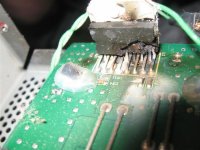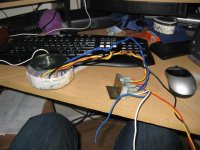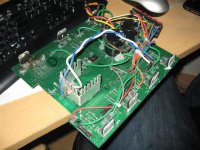My z-680s seem to have taken their last breath. After stretching their legs with some good bass, the system shut off. I replaced the blown fuse with a new slow blow fuse and was greeted with a short (.5 second) hum and some sparks and smoke. What most likely failed, and can I repair it?
That is not a transistor. It is a TDA7293 chipamp.
Ah, excuse my n00bness. Anyway, can these just be replaced? Or is it likely that other components are fried as well.
well I know in the logitechs, two of the chipamps are bridged for the sub.. Now I don't know how to tell which ones are bridged or not, or if that even matters.... And are there any newb diys sitting around for how to check my power supply? I have my multimeter here... But pretty clueless.
So upon further disassembly, it appears that the sub is blown, sounds like the voice coil is destroyed. So Now I am going to have 7 TDA7293s and some of the other good parts from this amp... so who wants to help me build my first amp? Looking at the chip amps everyone here has built, has got me inspired.
The PCB looks damaged - those blackened traces and also it appears there is a charred area under the chip. The components near those traces have almost certainly fried.
Furthermore, it is likely that the subwoofer speaker's voice coil has also fried (probably what fried the chipamps). Push the cone of the speaker in and out. If it is not smooth, and feels like it grates, the voice coil is fried.
Where did that large blob of solder come from?
I'm afraid I couldn't recommend attempting repair - the damage looks too great.
Furthermore, it is likely that the subwoofer speaker's voice coil has also fried (probably what fried the chipamps). Push the cone of the speaker in and out. If it is not smooth, and feels like it grates, the voice coil is fried.
Where did that large blob of solder come from?
I'm afraid I couldn't recommend attempting repair - the damage looks too great.
The PCB looks damaged - those blackened traces and also it appears there is a charred area under the chip. The components near those traces have almost certainly fried.
Furthermore, it is likely that the subwoofer speaker's voice coil has also fried (probably what fried the chipamps). Push the cone of the speaker in and out. If it is not smooth, and feels like it grates, the voice coil is fried.
Where did that large blob of solder come from?
I'm afraid I couldn't recommend attempting repair - the damage looks too great.
When I shake the subwoofer, I can hear something in the voice coil rattling around and hitting the dust cap area. Plus it is grindy when pushing in the cone.
The blob of solder is actually hot glue over a small capacitor. Seems like logitech deemed it necessary to hot glue random things.
Well, what I want to do is put an extra 10 inch sub that I have lying around into this box and build my own amp. I have 2 new TDA7293s on the way, plus the 5 remaining undamaged ones on here. I also have the transformer etc from my existing amp, and I want to build my own chipamp to power it. Is this a reasonable goal?
If I want to power a JL10W0v0 I have... could I buy this..
http://cgi.ebay.com.my/150W-3-x-LM3...0?hash=item4ceb397333&_trksid=p3286.m63.l1177
and then use the existing pieces of my power supply and make it all work?
http://cgi.ebay.com.my/150W-3-x-LM3...0?hash=item4ceb397333&_trksid=p3286.m63.l1177
and then use the existing pieces of my power supply and make it all work?
any idea what rating the transformer is, and what voltages it puts out?
They claim 500W RMS and THX certification but then they use these chips? I dont think so!
The main thing of value from the original circuit will be the decoder circuit. You say you have little experience though, so I'm not sure if building better amps but using the original decoder circuitry is within your abilities. Don't want to sound snobbish just would rather not get your hopes up, possibly spend money and then not be able to complete it.
They claim 500W RMS and THX certification but then they use these chips? I dont think so!
The main thing of value from the original circuit will be the decoder circuit. You say you have little experience though, so I'm not sure if building better amps but using the original decoder circuitry is within your abilities. Don't want to sound snobbish just would rather not get your hopes up, possibly spend money and then not be able to complete it.
Last edited:
any idea what rating the transformer is, and what voltages it puts out?
They claim 500W RMS and THX certification but then they use these chips? I dont think so!
The main thing of value from the original circuit will be the decoder circuit. You say you have little experience though, so I'm not sure if building better amps but using the original decoder circuitry is within your abilities. Don't want to sound snobbish just would rather not get your hopes up, possibly spend money and then not be able to complete it.
The transformer is a Tenpao Model # TOU543005F0
The diagram on the side shows the input from the wall 120v black 0v white and output with a 26.2v orange, 0v black, 26.2v yellow, and then a 14.0v blue and 0v blue.
So how can I use the original decoder circuitry? Since I blew the original 8ohm sub that was in there, I dropped in my JL 10w0v0 which is a 4ohm (I am pretty sure). Not sure how much of a difference that makes.
It seemed like if my transformer had the correct output voltage, then I could just buy one of those amps that I linked in my previous post from ebay and be ready to rock, but I am a noob, so there is probably much that I am overlooking.
I am attaching pictures of the mentioned transformer and associated rectifier bridges (model number KBPC1001 on each) Also is a picture of my entire remaining amp board.
Note: Thanks for helping me jaycee, no worries about feeling snobbish, I appreciate you helping me find a solution that is within my abilities.
I would not recommend bridged LM3886 amps or any chipamps really to drive a 4 ohm sub. For this you really need a discrete amp with a decent heatsink and capable power transistors, especially if you like to pump bass. As the destroyed chip shows, chip amps just do not have the SOA (safe operating area) for this.
You could use the surviving chips to drive the satellite speakers. They are ample for this task.
I'm also against those chinese kits on eBay. People have bought them here and said that they come with fake parts. It wouldn't surprise me.
You could use the surviving chips to drive the satellite speakers. They are ample for this task.
I'm also against those chinese kits on eBay. People have bought them here and said that they come with fake parts. It wouldn't surprise me.
I would not recommend bridged LM3886 amps or any chipamps really to drive a 4 ohm sub. For this you really need a discrete amp with a decent heatsink and capable power transistors, especially if you like to pump bass. As the destroyed chip shows, chip amps just do not have the SOA (safe operating area) for this.
You could use the surviving chips to drive the satellite speakers. They are ample for this task.
I'm also against those chinese kits on eBay. People have bought them here and said that they come with fake parts. It wouldn't surprise me.
So are there any kits I could buy to build my own discrete amp? I am trying to do this as inexpensively as possible. My goal was to try and re-use components from the dead logitechs, but I guess that doesn't make sense for my application.
Anyway, I looked around online and I am having trouble finding a clear answer as to what the difference is between a discrete amp and a chipamp.
- Status
- This old topic is closed. If you want to reopen this topic, contact a moderator using the "Report Post" button.
- Home
- Amplifiers
- Chip Amps
- Logitech z-680 amp repair


